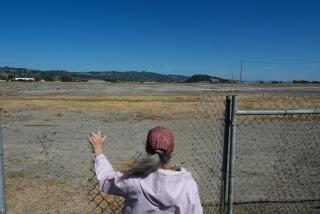Dark Secrets Come to Light in New History of ‘Radium Girls’
OTTAWA, Ill. — The year was 1923, a giddy time for a small-town teenager who had no money for college but found herself able to buy silk dresses and high-heeled shoes.
Margaret Looney, a soft-spoken redhead known as Peg, was fresh out of high school when she and dozens of other young women were hired to paint glow-in-the-dark watch dials at the newly arrived Radium Dial Co.
It was no easy task to trace the tiny numbers on the watches, made popular by their use in World War I. So the women were encouraged to make a fine point on their brushes by rolling the tips on their tongues before dipping them in the radium-laced paint.
“Not to worry,” their bosses told them. “If you swallow any radium, it’ll make your cheeks rosy.”
Discovered in 1898 by Marie Curie, the naturally occurring radioactive element was the wonder substance of the new century, thought to cure everything from arthritis to cancer. The women at Radium Dial sometimes painted their teeth and faces and then turned off the lights for a laugh.
What they didn’t know was that the substance was killing some of them.
Radium Dial and its successor, Luminous Processes, are gone. But the radium scattered when their buildings were destroyed in 1969 and 1984 remains in Ottawa, a sleepy river town in north central Illinois.
Some folks would just as soon forget the legacy of the odorless, nearly invisible, substance. “I’ve never been too thrilled about all the publicity that’s been handed out about this over the years,” says Jim Thomas, mayor of Ottawa from 1967 to 1987.
“Most folks in town would like to put that thing to rest,” he says. “They’d just like to get on with their lives.”
It has, however, been tough for Ottawa to ignore. Federal money to clean up four remaining Superfund sites laced with radium has run out, and officials say costs could rise to $100 million. That’s nearly three times the money spent since 1994 to dig up a football field, a front yard and eight other town sites.
“The tragedy really still lives there,” says Ross Mullner, an associate professor of health policy at the University of Illinois-Chicago. He is currently searching for a publisher for his book, “Deadly Glow.”
That tragedy, he says, began with the dial painters, who worked in studios in Ottawa; Orange, N.J.; Waterbury, Conn.; and on Long Island, N.Y.
Peg Looney was one of an estimated 4,000 workers nationwide.
The eldest daughter in an Irish-Catholic family with 10 children, Looney grew up in a house not far from Radium Dial. A 1922 yearbook from her all-girl Catholic high school describes the senior as a bookworm, with “a voice ever so soft, gentle and low” prone to the occasional giggling fit.
“She was everything you’d hope a big sister would be,” says one sister, who still lives in Ottawa but who asked not to be identified.
At Radium Dial, Looney would make about $18 a week, compared with the $5 she could make elsewhere. The company prospered as the glow-in-the dark concept expanded for use on military aircraft controls and the hugely popular Westclox “Big Ben” alarm clock.
All the while, staff doctors routinely checked the dial painters for radioactivity, though the women didn’t know it at the time.
Looney’s family later learned that she tested positive for radioactivity in 1925 and again in 1928--the year before she died. “I’m angry because they knew years before she died that she was full of radium,” her sister says. “And then they lied.”
Results of the tests would become public in a Chicago courtroom in 1938 after one worker, Catherine Wolfe Donahue, sued Radium Dial. She testified that she and a co-worker asked supervisor Rufus Reed why the company didn’t post the results of the physical exams.
“My dear girls, if we were to give a medical report to you girls, there would be a riot in the place,” Reed said, according to Donahue, whose testimony is documented in court records.
Donahue, who was so ill she had to be carried into the courtroom, died that same year, shortly after the company agreed to pay her a few thousand dollars. Earlier lawsuits filed by five Radium Dial workers in New Jersey also ended in settlement.
But most women who got sick never sued. “Let’s just say they didn’t have a whole lot of social authority. They couldn’t just bang on doors and get noticed,” says Claudia Clark, an assistant professor of history at Central Michigan University in Mount Pleasant, Mich., and author of the new book “Radium Girls.”
Deaths were often attributed to other causes, anemia one of the most common. But experts, including scientists at Argonne National Laboratories, now affirm that radium did kill some of the women.
There is still disagreement about how many. Some say a few; others believe radium caused hundreds to die or suffer bad health for years. “There are a bunch of cases where people know there’s something wrong,” Clark says.
Some women had tumors bulging from their jaws or leg bones, where radium was said to settle. Looney’s family watched in horror as she pulled teeth and parts of her jaw from her mouth.
Her declining health forced her to leave Radium Dial on Aug. 6, 1929. Eight days later, at age 24, she was dead.
An autopsy by a Radium Dial doctor listed diphtheria as cause of death. But her family has never believed that, in part because the company asked them to rush the funeral.
“They wanted the whole thing done with--just gone,” says Looney’s niece, Darlene Halm of Ottawa, recounting the story her mother told her. “It was like a big cover-up.”
Halm goes so far as to blame radium for a heightened rate of cancer around some of the Superfund sites.
“When I think back, I can say, ‘This one died of cancer. That one died of cancer. That one died of cancer,’ ” she says. That includes her parents, who--coincidentally or not--lived much of their lives in a house a stone’s throw from the old Radium Dial.
A 1997 study at Northern Illinois University in Dekalb documented an above-average cancer rate. But no follow-up search for a direct link has begun, in part due to lack of money and staff. “And, frankly, the community is not screaming,” says Ruth Anne Tobias, the researcher who oversaw the 1997 study.
Besides Illinois, at least two other states have radium hot spots. Cleanup on a radium-laced landfill in Glen Ridge, N.J.--the last of four towns in that state--is beginning this month, according to EPA spokesman Rich Cahill.
In all, the EPA expects to spend more than $144 million for radium cleanup in New Jersey and New York, with detoxification begun in West Orange and Orange, site of the now-defunct U.S. Radium Co. A site in Montclair, N.J., is now free of radium, says Cahill, as is the site of the former Radium Chemical Co. in New York’s borough of Queens.
Officials at the Connecticut Department of Environmental Protection have found contamination--including in apartment buildings that are former dial-painting studios--in Waterbury, Bristol, New Haven and other towns. With a report due early next year, state officials say they are asking the EPA to help with federal funds.
Unaware of the problems with radium, Lisa Skoli moved to Ottawa two years ago. She says she’s concerned for her 12-year-old son and about some of her neighbors’ indifference.
“This is really a little town, and it has a little town mentality,” says Skoli. “If everybody says it’s OK, it’s OK. They say, ‘We have to worry that we have enough money to feed our kids.’
“But you ask them if they know what radium does to their kids, and they don’t know.”
Scientists at Argonne do know, at least in part, what happened to Peg Looney.
Twenty years ago, they exhumed her body and those of about 100 others nationwide. Using a tiny measurement named for Madame Curie, they found 19,500 “microcuries” of radium in Looney’s bones, more than 1,000 times the amount scientists consider safe.
Robert Rowland, the Batavia, Ill., scientist who oversaw the Argonne study, calls this “an awful lot of radium . . . one of the highest we found.”
The results were used, in part, to develop safety standards for plutonium workers.
“I guess you could look at this story and say, ‘It’s the canary in the coal mine,’ ” says Katie Troccoli, a real estate agent and outspoken environmental activist in Ottawa.
“It was a terrible thing to happen,” she says. “Somehow, we have to get the word out.”
More to Read
Sign up for Essential California
The most important California stories and recommendations in your inbox every morning.
You may occasionally receive promotional content from the Los Angeles Times.










